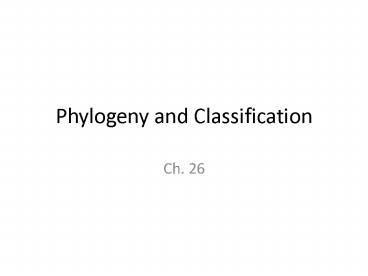Phylogeny and Classification - PowerPoint PPT Presentation
1 / 14
Title:
Phylogeny and Classification
Description:
Phylogeny and Classification Ch. 26 Vocabulary Phylogeny-evolutionary history of a species or group of species Systematics-discipline focused on classifying organisms ... – PowerPoint PPT presentation
Number of Views:93
Avg rating:3.0/5.0
Title: Phylogeny and Classification
1
Phylogeny and Classification
- Ch. 26
2
Vocabulary
- Phylogeny-evolutionary history of a species or
group of species - Systematics-discipline focused on classifying
organisms and determining their evolutionary
relationships - Taxonomy-scientific discipline of how organisms
are named and classified - Binomial nomenclature-two part format of
scientific names developed by Carolus Linnaeus
(18th c.)
3
Figure 26.3
Species Panthera pardus
Genus Panthera
Family Felidae
Order Carnivora
Class Mammalia
Phylum Chordata
Kingdom Animalia
Domain Bacteria
Domain Archaea
Domain Eukarya
4
Phylogenetic tree
- Branching pattern often matches how taxonomists
have classified groups of organisms - Changes as more evidence is added, such as
genetic information that shows two species
closely related genetically (though features are
less similar) - Does not always indicate absolute ages of species
- Shows common ancestors
5
Figure 26.4
Order
Family
Genus
Species
Panthera pardus (leopard)
Felidae
Panthera
Taxidea taxus (American badger)
Taxidea
Carnivora
Mustelidae
Lutra lutra (European otter)
Lutra
Canis latrans (coyote)
Canidae
Canis
Canis lupus (gray wolf)
6
Molecular Clocks
- Tool to measure the absolute time of evolutionary
change based on the observation that some genes
and other regions of genomes appear to evolve at
constant rates
7
Figure 26.19
90
60
Number of mutations
30
0
30
60
90
120
Divergence time (millions of years)
Mammal molecular clock. Number of accumulated
mutations in 7 proteins has increased over time
in a consistent manner for most mammal species.
Green data points are primates, proteins have
evolved more slowly.
8
Three domains of life
- Image on next slide based on rRNA gene sequences.
- Branch lengths are proportional to the amount of
genetic change in each lineage - Lineages dominated by multicellular organisms are
shown in red - All other lineages consist solely or primarily of
single-celled organisms
9
Figure 26.21
Eukarya
Land plants
Dinoflagellates
Forams
Green algae
Diatoms
Ciliates
Red algae
Amoebas
Cellular slime molds
Euglena
Trypanosomes
Animals
Leishmania
Fungi
Green nonsulfur bacteria
Sulfolobus
Thermophiles
(Mitochondrion)
Spirochetes
Chlamydia
Halophiles
COMMON ANCESTOR OF ALL LIFE
Green sulfur bacteria
Bacteria
Methanobacterium
Cyanobacteria
Archaea
(Plastids, including chloroplasts)
10
Bacteria and Archaea (ch. 27)
- Unicellular
- Diameter typicall 0.5-5 micrometers
- Variety of shapes
- Well organized
- Achieve all organisms functions in single cell
11
Cell surface
- Bacterial cell walls contain peptidoglycan
- Archaea cell walls have polysaccharides and
proteins, not peptidoglycan - Bacteria separated into 2 groups
- Gram-positive simpler walls, relatively large
amount of peptidoglycan - Gram-negative less peptidoglycan, structurally
more complex, outer membrane contains
lipopolysaccharides (carbslipids)
12
Motility
- Half of all prokaryotes capable of taxis
(directed movement toward or away from stimulus) - Flagella (single, flagellum)
13
DNA
- Lack complex compartmentalization found in
eukaryotes - Less DNA than eukaryotes
- DNA usually in a circular chromosome
- No nucleus, DNA in nucleoid
- Also DNA in smaller rings called plasmids
14
Diversity Rapid reproduction and mutation
- Do not reproduce sexually, instead by binary
fission - Total number of mutations in 4,300 E. coli genes
per day (2000 bacteria for each mutated gene) in
1 human is 9 million mutations - No meiosis and fertilization, instead
transformation, transduction, conjugation - Read about these three and in groups of four,
develop a way to demonstrate each































